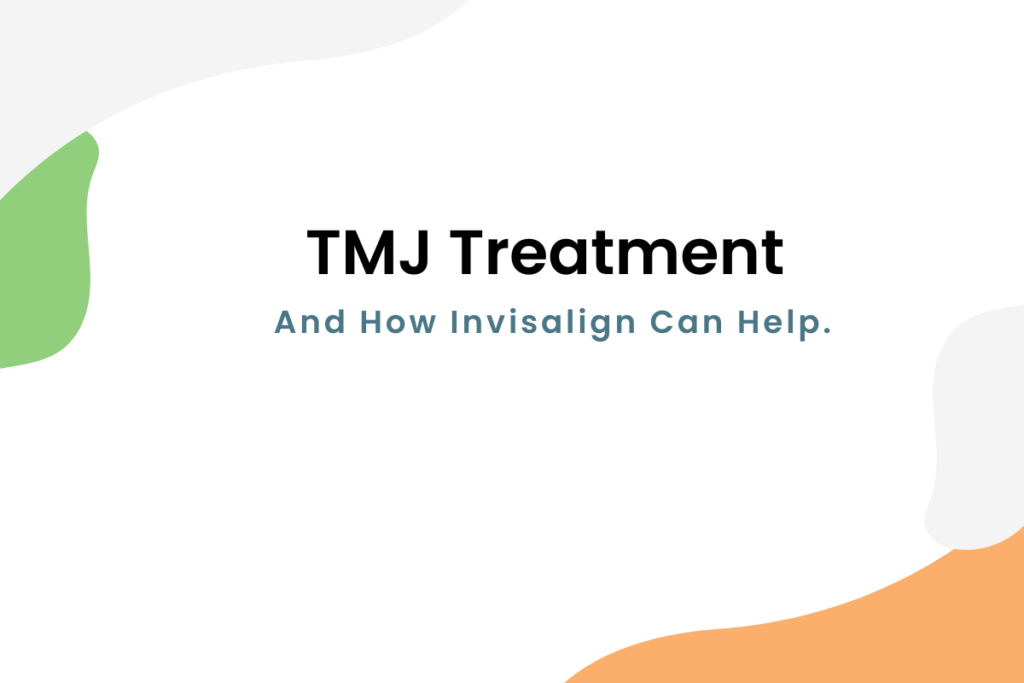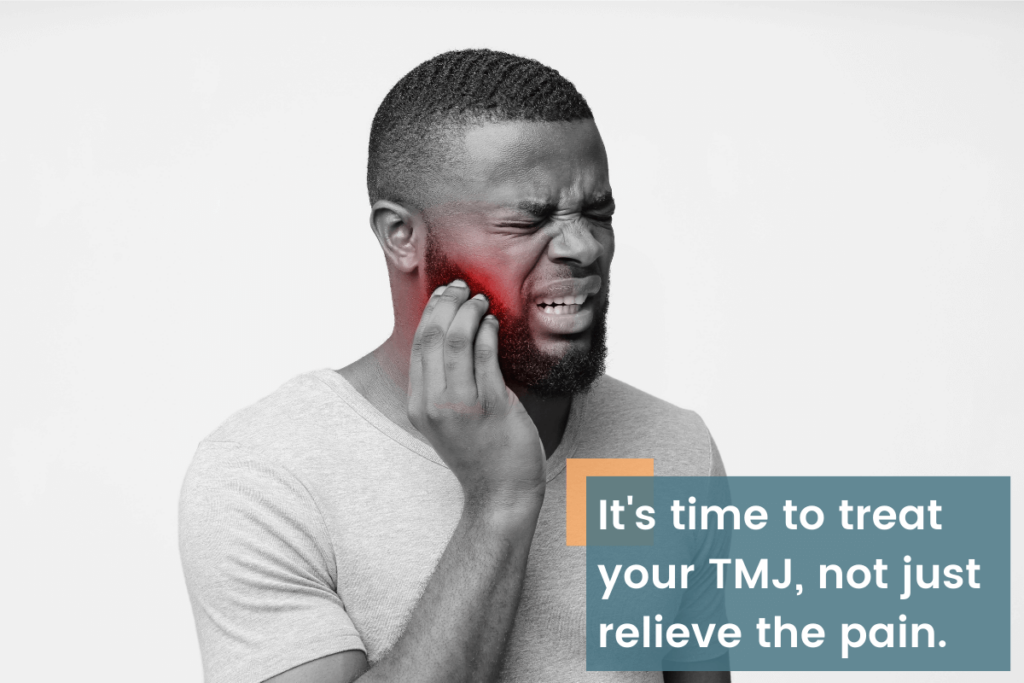
How often do we appreciate the simple act of opening and closing our mouths? When a yawn, a laugh, or a bite of our favorite food becomes a source of discomfort, we realize the importance of the small hinge that makes these actions possible – the temporomandibular joint. TMJ treatment can help alleviate this discomfort and restore normal function.
If you’re experiencing a temporomandibular joint, we want to help. In this post, we help you understand temporomandibular disorders, how to relieve pain, and how Invisalign clear aligners from a trained doctor or dentist can help your pain relief.
Short Summary
- TMJ (Temporomandibular Joint Disorders) is a collection of over 30 conditions that cause pain and difficulty in the jaw joint and muscles.
- Treatment options for TMJ disorders range from noninvasive treatments to more intensive medication-based and surgical procedures.
- Invisalign treatment provides numerous advantages, including non-invasiveness, customizability, efficacy in relieving TMJ pain, comfortability & removability making it an ideal solution for many patients.

What is TMJ (Temporomandibular Joint Disorders)?
TMJ disorders are a collection of over 30 conditions that lead to pain and difficulty in the jaw joint and muscles that control jaw movement, affecting both upper and lower teeth.
Imagine the discomfort of gnawing on a soft piece of bread, or the pain that shoots through your jaw as you burst into laughter at a joke. That’s the reality for those suffering from TMJ disorders.
From talking to eating to expressing emotions, the impact of these disorders seeps into various aspects of daily life, making even simple activities a challenge.
The effects of TMJ dysfunction vary from person to person. Some may experience a temporary issue that resolves within a few weeks, while others may suffer from a chronic condition that affects their quality of life and ability to relieve TMJ pain.
Understanding TMJ Disorders
Temporomandibular joint disorders, also known as temporomandibular joint TMJ, are a group of conditions that affect the temporomandibular joints, which connect the jaw to the skull, and cause discomfort.
Think of the TMJ as a sophisticated hinge that allows your jaw to move up and down, side to side, and even forward and back – all essential movements for speech, eating, and facial expression.
These jaw joints play a crucial role in our daily lives, and temporomandibular disorders can significantly impact their function.
When this hinge is thrown out of balance, the result is a myriad of TMJ disorders marked by discomfort, difficulty in chewing, and even headaches. It’s like a see-saw that’s off balance, making the ride uncomfortable and unpredictable.
Types of TMJ Disorders
There are many types of TMJ disorders and they can vary greatly. The two primary types being myofascial pain and internal derangement.
Myofascial Pain
Myofascial pain, akin to a muscle cramp, is caused by tension and spasms in the muscles that control jaw movement. This type of TMJ disorder is like a stubborn knot in a shoelace, causing discomfort and limiting movement.
Internal Derangement
On the other hand, internal derangement results from a misalignment of the jaw joint, similar to a dislocated shoulder or a slipped disc. The jaw joint, like a misaligned gear in a clock, doesn’t function smoothly, leading to clicks, pops, and pain.

Common Symptoms
Like a chameleon, TMJ disorders can present a wide array of symptoms, often making them difficult to diagnose. The most common signs include:
- Discomfort or sensitivity in the jaw
- Popping or clicking of the jaw
- Difficulty chewing
- Headaches
It’s as if your jaw has become a squeaky door hinge, providing an unsettling soundtrack to your daily activities.
Certain behaviors like forceful yawning, chewing gum, or even undue stress can aggravate symptoms consistent with those of irritable bowel syndrome. A 2017 study estimated that up to 60% of TMJ sufferers have experienced abdominal pain similar to IBS or have been diagnosed with IBS.
It’s like poking a wound, causing more discomfort and prolonging the healing process. To alleviate the symptoms, it’s recommended to eat soft foods. But of course, this is merely a temporary relief.
Hence, it’s important to consult a healthcare provider if you experience persistent jaw pain, facial pain, headaches, or other TMJ symptoms.
Causes of TMJ Disorders
The causes of TMJ disorders are as varied as the symptoms they produce.
It is believed that genetics, stress, and injury may play a role in the development of TMJ disorders. Like the ingredients of a complex recipe, these factors mix together in different ways to create a unique manifestation of the disorder in each individual.
For example, someone with a genetic predisposition to TMJ disorders might find that their symptoms are exacerbated by stress, leading to increased jaw clenching and teeth grinding.
Or, an injury to the jaw can trigger the onset of TMJ symptoms, even in someone who has never previously had any issues. It’s like a domino effect, where one factor can set off a chain reaction leading to the manifestation of TMJ disorder.

How to Cure TMJ
While the term ‘cure’ may be ambitious, it is certainly possible for some people to significantly improve or even resolve the symptoms of TMJ within a few weeks or months through home remedies and lifestyle changes.
Think of it as taming a wild horse; with patience and the right techniques, you can bring it under control.
Addressing the underlying causes and implementing the appropriate treatments are essential steps toward curbing the discomfort caused by TMJ disorders. This means that, for many people, simple home remedies or lifestyle changes may not be enough to eliminate their TMJ pain and ‘cure’ them forever.
Like fixing a leaky faucet, it’s not just about stopping the water flow – it’s about finding and fixing the source of the leak.

How to Treat TMJ
When it comes to treating TMJ disorders, one size does not fit all. There is a broad spectrum of treatment methods available, ranging from:
- self-management techniques
- physical therapy
- medications
- oral appliances
- surgery
The right solution for you depends on the specifics of your discomfort, the causes, its severity, and what your priorities are in seeking relief.
For instance, TMJ pain relief can be achieved through medication. But alternative methods like physical therapy can help relieve pain and manage symptoms too if you prefer to take a more natural approach.
In more severe cases, surgical interventions may be necessary, but we would advise you to avoid invasive procedures like these if at all possible. (It’s good for your wallet, too.)
The best thing to do is speak with a licensed professional with your best interest at heart.
TMJ Pain Relief
When it comes to TMJ pain relief, the first line of defense often involves noninvasive methods like limiting jaw movements and maintaining relaxed muscles.
It’s akin to treating a sprained ankle; you avoid putting pressure on it and use measures like rest and elevation to reduce swelling and promote healing.
In addition to these measures, engaging in specific types of jaw exercises may also help in reducing TMJ pain. These exercises are like physiotherapy for your jaw, helping to strengthen the muscles and improve flexibility, thus reducing discomfort.
Alternative Relief Methods & At-Home TMJ Remedies
Beyond traditional medical interventions, there are many alternative relief methods and at-home remedies available for TMJ disorders. Think of these as your personal toolkit for managing TMJ symptoms – readily accessible and easy to implement.
Stress management techniques like meditation and yoga can help relax the jaw muscles, while physical therapy exercises can improve jaw mobility and reduce pain. In some cases, the use of a mouth guard or muscle relaxants might be recommended to address teeth grinding or jaw clenching.
These methods are like a personalized training program, designed to make your jaw stronger, more flexible, and less prone to pain.
TMJ Treatment Options
While noninvasive treatments are typically the first choice for TMJ disorders, there are instances where more focused treatments may be required. These range from medication-based treatments to orthodontic treatment to the far extremes of surgical procedures.
Each offers its own set of advantages and risks, but only one of these options is non-invasive and uses natural treatment methods only: orthodontic treatment.
For instance, arthroscopy, arthroplasty, and total joint replacement are all viable surgical options for TMJ pain relief. But these are advised only for severe cases where other treatments have failed and your pain is extreme.
These procedures are a last resort, used only when other methods have been exhausted and the pain persists.
Invisalign Treatment for TMJ Pain Relief
In the quest for TMJ relief, one treatment option that has garnered attention is Invisalign.
This orthodontic treatment uses clear, removable aligners to gradually shift teeth into the desired position. Picture it as a gentle and consistent nudge, guiding your teeth into the right alignment and easing pressure on the temporomandibular joint.
Invisalign treatment can aid with TMJ pain relief by realigning the upper and lower jaws, thus reducing the pressure on the temporomandibular joint.
It’s like a tailor-made suit, perfectly fitting the structure of your mouth and subtly adjusting the alignment for optimal comfort and efficacy.
Does Invisalign Help Jaw Alignment?
Yes, Invisalign helps to improve jaw alignment. By realigning the upper and lower jaws, Invisalign provides a more balanced and harmonious bite, which can alleviate the strain on the TMJ and reduce symptoms.
Can Invisalign Fix TMJ Problems?
Like an expert mechanic can fix a misaligned wheel, Invisalign can address TMJ issues by realigning the teeth. This reduces strain on the TMJ and alleviates inflammation and discomfort caused by TMJ disorder.
Invisalign can significantly help with jaw alignment in some cases, which also relieves pain on jaw joints and jaw pain overall.
Like using the right key to unlock a door, the effectiveness of Invisalign in treating TMJ disorders hinges on an accurate diagnosis.
But if the patient’s misaligned or overcrowded teeth are the source of the TMJ issue, Invisalign treatment can prove extremely beneficial.
Advantages of Invisalign Treatment for TMJ Relief
In comparison to traditional braces, Invisalign offers a more comfortable and less intrusive solution for jaw misalignment.
It’s like choosing a custom-made suit; not only is the fit better, but it also provides a more comfortable and effective solution.
Besides the possibility that Invisalign treatment could help in improving and maybe even relieving symptoms associated with TMJ disorders, it also offers several other benefits. From its noninvasive nature to its customizability, Invisalign provides a unique blend of advantages that make it a viable option for TMJ relief.
In addition to its efficacy in reducing pain, Invisalign offers comfort and removability, making it a practical and convenient choice for many patients.
Conclusion
TMJ disorders, much like a misaligned gear in a clock or a stubborn knot in a shoelace, can cause discomfort and affect the quality of life.
However, with the right treatment and lifestyle modifications, it’s possible to alleviate the symptoms and regain control over your jaw’s movements.
The key to effective treatment lies in an accurate diagnosis and a tailored treatment approach, which can include exercises, remedies, or even Invisalign.
If you’re ready to treat your facial pain from TMJ, we want to help. Your accelerated Invisalign Vancouver treatment at Dr. Peter Brawn includes:
- up to 75% less discomfort during orthodontic treatment
- better treatment results up to 2x faster than average in Vancouver
- visible progress with your smile in as little as 4 months

Frequently Asked Questions
What is the best way to treat TMJ?
The best way to treat TMJ is to maintain the resting position of your jaw, correct your posture, get a good night’s sleep, use a hot or cold compress, reduce stress, exercise your jaw, take notice of bad habits, and avoid certain activities and foods.
These activities can help reduce the pain and discomfort associated with TMJ. Maintaining the resting position of your jaw can help reduce the tension in your jaw muscles. Correcting your posture can help reduce the strain on your jaw muscles. Getting a good night’s sleep can help reduce the inflammation in your jaw muscles. Using a hot or cold compress can help reduce pain.
If you want to go beyond treating TMJ, and actually correct underlying jaw alignment issues, consider Vancouver Invisalign.
What does a TMJ flare-up feel like?
A TMJ flare up can cause general jaw pain, frequent headaches, clicking and popping of the jaw, and ear pain ranging from a dull ache to sharp, searing, severe pain.
We recommend consulting an orthodontic doctor or dentist who does Invisalign in Vancouver to understand how the positioning of your upper and lower teeth, the state of your jaw muscles, and alignment of your jaw and jaw joints may all be contributing to your chronic pain and TMJ disorder.
An orthodontic doctor or dentist may be able to identify nonsurgical treatments that could help your TMD symptoms without requiring surgery or constant use of pain relievers.
What is the main cause of TMJ?
The main cause of TMJ is excessive strain on the jaw joints and the muscle group that controls chewing, swallowing, and speech, which is commonly caused by bruxism (teeth grinding and clenching) or trauma to the jaw, head, or neck.
Other causes include jaw injuries, arthritis, and everyday wear and tear.
What is TMJ?
TMJ is a condition that affects the jaw joint and associated muscles, leading to difficulty in jaw muscles and joint movement and discomfort.
Symptoms of TMJ can include pain in the jaw joint, difficulty in opening and closing the mouth, clicking or popping sounds when the jaw moves, and headaches. Treatment for TMJ can include physical therapy.


